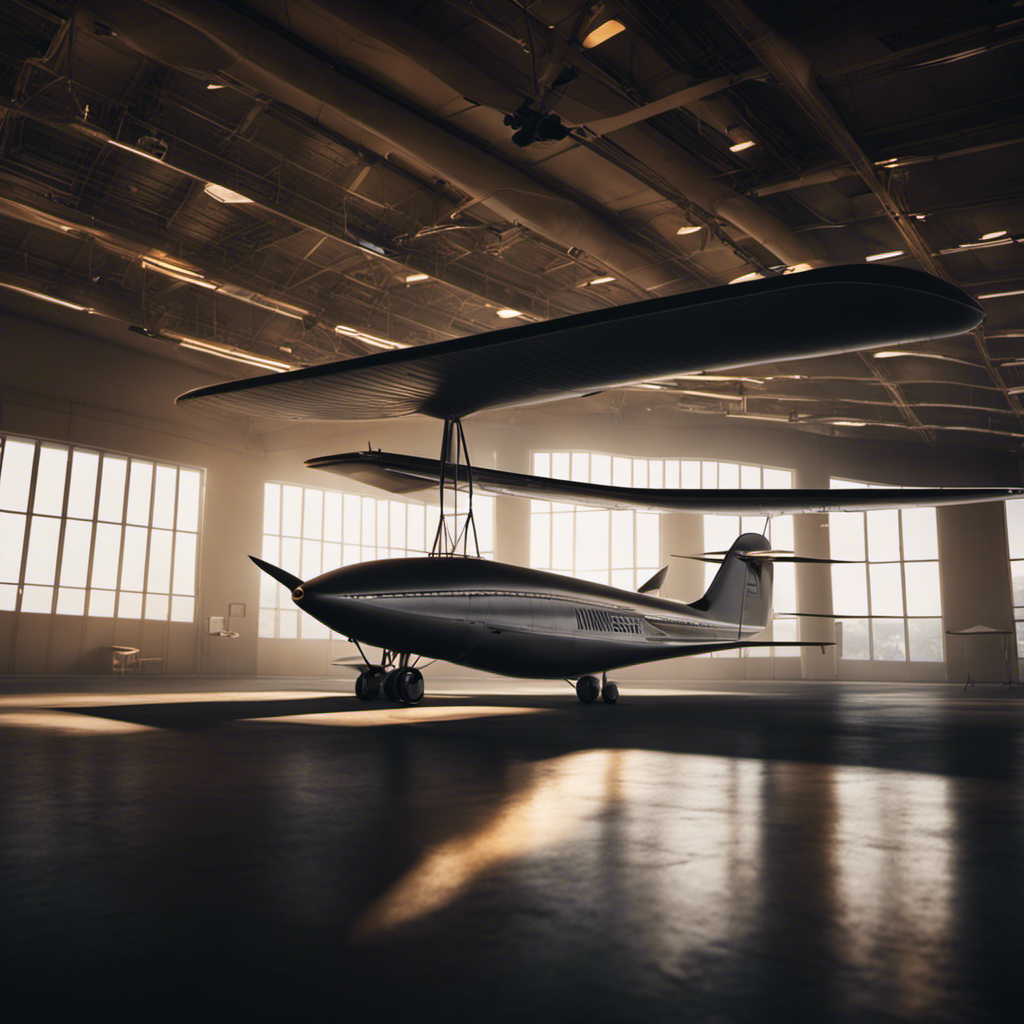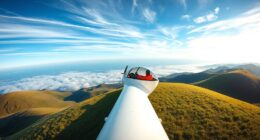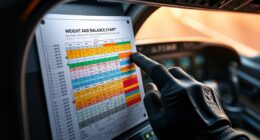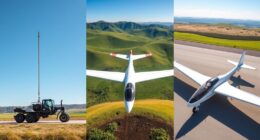I’m about to take you on a thrilling journey through the intricate workings of a glider. Get ready to dive deep into the fascinating world of glider components.
From the wing structure to the fuselage design, the tail assembly to the control surfaces, we’ll explore every nook and cranny.
Buckle up and prepare to be amazed by the precision and complexity of the landing gear system, cockpit layout, avionics, and instrumentation.
And fear not, we’ll also uncover the safety features that make gliders soar with confidence.
Let’s get started!
Key Takeaways
- Glider components include the wing structure, fuselage design, tail assembly, and control surfaces.
- The choice of materials for glider components impacts weight and maneuverability.
- Control surfaces such as ailerons, elevators, rudders, and spoilers control pitch, roll, and yaw movements.
- Safety features in gliders include emergency parachutes, cockpit layout and instrumentation, and safety inspections and maintenance.
The Wing Structure
The wing structure of a glider is composed of various components that work together to provide lift and stability. The design of the wing is crucial for the performance and maneuverability of the glider. It is built based on aerodynamic principles to optimize its efficiency in generating lift.
The main structural element of the wing is the spar, which runs along the length of the wing. It provides the necessary strength to support the weight of the glider and withstand the forces experienced during flight. The spar is typically made of lightweight materials such as carbon fiber or aluminum alloy to minimize weight while maintaining structural integrity.
Attached to the spar are the ribs, which give the wing its shape and provide additional support. The ribs are spaced evenly along the wing, creating a framework for the wing skin. The wing skin, usually made of fiberglass or composite materials, covers the ribs and gives the wing its aerodynamic shape. It is designed to be smooth and streamlined, reducing drag and improving the glider’s performance.
The wing structure also includes control surfaces such as ailerons and flaps, which allow the pilot to control the glider’s roll and pitch. These surfaces are hinged to the trailing edge of the wing and can be manipulated to change the lift and drag characteristics of the wing, enabling the glider to perform various maneuvers.
In conclusion, the wing structure of a glider is carefully designed to optimize its aerodynamic performance. The spar, ribs, wing skin, and control surfaces all play a crucial role in providing lift, stability, and control during flight.
Transitioning to the subsequent section about the fuselage design, the wing structure is just one component of the overall design that contributes to the glider’s performance.
The Fuselage Design
You’ll notice that the fuselage design plays a crucial role in the performance of your glider. The fuselage is the main body of the glider, connecting the wings and the tail assembly. It is responsible for housing the cockpit, providing structural support, and contributing to the overall aerodynamics of the glider. The choice of fuselage materials greatly impacts the glider’s weight, strength, and maneuverability.
When it comes to fuselage materials, there are several options to consider:
- Aluminum: Lightweight and strong, aluminum is a popular choice for glider fuselages. It offers good durability and is relatively easy to repair.
- Carbon Fiber: Known for its high strength-to-weight ratio, carbon fiber is a lightweight and rigid material. It provides excellent structural integrity and reduces overall weight.
Fuselage aerodynamics also play a significant role in the glider’s performance. A streamlined fuselage design helps reduce drag, allowing the glider to maintain higher speeds and improve overall efficiency. Smooth surfaces, carefully designed contours, and the integration of wing-fuselage junctions all contribute to minimizing drag.
With the fuselage design optimized for performance, the glider is ready to move on to the next crucial component: the tail assembly.
The Tail Assembly
Now that we have covered the fuselage design, let’s explore the tail assembly and its importance in your glider’s performance.
The tail assembly of a glider consists of the horizontal stabilizer, vertical stabilizer, and the control surfaces attached to them. The primary function of the tail assembly is to provide stability and control during flight.
The horizontal stabilizer, located at the rear of the glider, helps maintain longitudinal stability. Its shape and size are crucial for achieving the desired aerodynamic characteristics. It prevents the glider from pitching up or down excessively, ensuring a balanced flight.
The vertical stabilizer, on the other hand, is responsible for maintaining directional stability. It prevents unwanted yawing or turning movements, keeping the glider on its intended flight path.
To further enhance the performance of the tail assembly, various aerodynamic principles are applied. The shape of the tail surfaces, such as airfoils, is carefully designed to minimize drag and maximize lift. This allows for better maneuverability and efficiency during flight.
The tail assembly is an integral part of the glider’s overall aerodynamics. Its design and performance directly impact the glider’s stability, control, and maneuverability.
Now that we have explored the importance of the tail assembly, let’s move on to the next section and discuss the control surfaces, which play a vital role in controlling the glider’s movement in flight.
The Control Surfaces
When it comes to controlling the movement and stability of a glider, the control surfaces play a crucial role. These surfaces, which are typically located on the wings and tail, are designed to manipulate the airflow around the aircraft to achieve desired maneuvers and responses.
The main function of control surfaces is to provide control and stability in pitch, roll, and yaw movements. There are several types of control surfaces, including ailerons, elevators, rudders, and spoilers, each serving a specific purpose in controlling the glider’s flight.
Function of Control Surfaces
The control surfaces on a glider, such as the ailerons and elevator, play a crucial role in maneuvering the aircraft in flight. These control surfaces are designed to provide control over the pitch, roll, and yaw of the glider, allowing the pilot to maintain stability and perform various maneuvers.
Control Surface Effectiveness:
- Ailerons: These control surfaces are located on the wings and are used to control the roll of the glider. By deflecting one aileron up and the other down, the pilot can create differential lift, resulting in a roll motion.
- Elevator: Located on the tail, the elevator controls the pitch of the glider. By deflecting the elevator up or down, the pilot can control the nose-up or nose-down attitude of the glider.
Control Surface Limitations:
- Control Authority: The effectiveness of the control surfaces is limited by the glider’s design and aerodynamic forces. In extreme flight conditions, such as high speeds or strong winds, the control surfaces may become less effective.
- Structural Limits: The control surfaces are designed to withstand certain loads and forces. Exceeding these limits can lead to structural failure or loss of control.
Understanding the effectiveness and limitations of the control surfaces is crucial for safe and efficient glider operation.
Types of Control Surfaces
Let’s take a look at the different types of control surfaces on a glider.
The ailerons and elevator are two essential control surfaces that contribute to the maneuverability and stability of the aircraft.
Ailerons, located on the wings, control the roll of the glider. They work in pairs, with one moving up while the other moves down. This asymmetrical movement generates differential lift, causing the glider to roll.
The elevator, positioned on the tail, controls the pitch. By moving up or down, it changes the angle of attack of the tail, affecting the glider’s pitch attitude. The design of the elevator is crucial for maintaining stability and control during flight.
With a solid understanding of aileron functionality and elevator design, we can now transition to exploring the landing gear system.
The Landing Gear System
To understand the landing gear system of a glider, you’ll need to examine its components and how they function together. The landing gear system plays a crucial role in the overall performance of a glider, as it ensures safe takeoffs and landings.
Here are the key components of a typical glider landing gear system:
-
Wheel and Tire Assembly: The glider’s landing gear is equipped with wheels and tires that provide support and allow for smooth ground handling. The size and type of wheel and tire assembly used depend on the specific glider model and its intended use.
-
Shock Absorption System: The landing gear system incorporates a shock absorption mechanism to minimize the impact forces during landing. This system usually consists of springs or hydraulic dampers that absorb and dissipate the energy generated upon touchdown.
-
Retraction Mechanism: Some gliders feature retractable landing gear, allowing for improved aerodynamic performance during flight. The retraction mechanism consists of hydraulic or electric actuators that retract the landing gear into the fuselage, reducing drag and improving glide efficiency.
Understanding the intricacies of a glider’s landing gear system is essential for pilots and enthusiasts alike. By optimizing the design and functionality of these components, glider performance can be enhanced, leading to safer and more efficient flights.
The Cockpit Layout
As a pilot, I understand the importance of having essential cockpit instruments readily accessible to ensure the safe operation of the aircraft. These instruments include the altimeter, airspeed indicator, and attitude indicator, which provide crucial information on altitude, speed, and aircraft orientation.
In addition to the placement of these instruments, the ergonomics of the cockpit design also play a significant role in ensuring pilot comfort and reducing fatigue during long flights.
Essential Cockpit Instruments
You’ll want to familiarize yourself with the essential cockpit instruments if you plan on gliding. These instruments provide crucial information to ensure a safe and successful flight. Here are the key instruments you’ll find in a glider cockpit:
- Altimeter: This instrument measures the altitude above sea level, helping you maintain the desired flight level.
- Air Speed Indicator: It displays the glider’s speed through the air, allowing you to adjust your flight accordingly.
- Variometer: The variometer indicates the rate of climb or descent, crucial for finding thermals and maintaining lift.
Cockpit Lighting: Proper cockpit lighting is essential for reading the instruments in low-light conditions.
Instrument Calibration: Regular calibration of the instruments ensures accuracy and reliability.
Understanding and correctly utilizing these cockpit instruments is vital for a successful gliding experience. Now, let’s delve into the importance of ergonomics and pilot comfort in the glider cockpit.
Ergonomics and Pilot Comfort
Understanding the importance of ergonomics and pilot comfort is crucial for a successful gliding experience. As a glider pilot, I am aware of the challenges that can arise from long hours in the cockpit.
Pilot fatigue is a real concern, and it can negatively impact safety and performance. That’s why seat adjustability is a vital feature in gliders. The ability to adjust the seat position allows pilots to find the optimal seating position, minimizing fatigue and promoting comfort during the flight.
This not only reduces the risk of developing physical discomfort but also helps in maintaining focus and concentration throughout the journey. The design of glider seats takes into account factors such as lumbar support, cushioning, and the ability to adjust the seat height, tilt, and backrest angle.
The Avionics and Instrumentation
Take a look at the avionics and instrumentation, they play a crucial role in the performance of a glider. Avionics technology has seen significant advancements in recent years, allowing pilots to have access to a wide range of information and tools to enhance their flying experience. The instruments in a glider are meticulously calibrated to ensure accuracy and reliability during flight.
Here are two key aspects to consider when discussing avionics and instrumentation in a glider:
-
Avionics Technology:
-
GPS Navigation Systems: Gliders are equipped with GPS navigation systems that provide real-time positioning information, allowing pilots to accurately plan their routes and navigate through challenging terrains.
-
Flight Data Recorders: These devices record data such as altitude, airspeed, and heading, providing valuable information for post-flight analysis and improving future flight performance.
-
Instrument Calibration:
-
Airspeed Indicator: This instrument measures the speed at which the glider is moving through the air. It must be calibrated regularly to ensure accurate readings, as even slight variations can impact flight performance.
-
Altimeter: The altimeter displays the glider’s altitude above sea level. Regular calibration is essential to ensure accurate altitude readings, which are crucial for maintaining safe flying conditions.
The Safety Features
One of the safety features in a glider is the parachute system, which can be deployed in emergency situations to ensure a safe landing. This system consists of a main parachute and a reserve parachute, both carefully packed and stored in the aircraft. In the event of a critical situation such as a loss of control or structural failure, the pilot can activate the parachute system, causing the main parachute to be released and deployed. The parachute creates drag, slowing down the descent rate and allowing the glider to land more safely.
In addition to the parachute system, gliders are equipped with several other safety features to enhance aerodynamic performance and reduce the risk of accidents. These include:
-
Winglets: These small, vertical extensions on the wingtips reduce drag and improve stability, allowing for more efficient and safer flight.
-
Anti-Spin Devices: These devices, such as spin-resistant airfoils or wing fences, help prevent or recover from spins, which can be dangerous and difficult to escape in a glider.
-
Cockpit Safety Harness: A secure and adjustable harness keeps the pilot firmly in place during flight, preventing them from being thrown around in turbulence or during abrupt maneuvers.
-
Crash-Resistant Structure: Gliders are designed with a strong and lightweight structure to withstand impact forces and protect the pilot in the event of a crash.
-
Emergency Locator Transmitter (ELT): An ELT is installed in the glider to transmit distress signals in the event of an accident, helping rescue teams locate the aircraft quickly.
Frequently Asked Questions
How Much Does a Glider Typically Weigh?
A glider typically weighs between 200 to 600 kilograms, depending on its size and construction materials.
The weight distribution of a glider is carefully balanced to ensure optimal flight performance. The glider’s overall weight is evenly distributed across its wings, fuselage, and tail section. This balance is crucial for maintaining stability and maneuverability during flight.
The weight of the glider is a critical factor that pilots and designers consider to ensure safe and efficient flying conditions.
What Is the Average Lifespan of a Glider?
The average lifespan of a glider is highly dependent on its maintenance requirements. Regular inspections, repairs, and proper storage can significantly extend the lifespan of a glider.
On average, a well-maintained glider can last anywhere from 20 to 30 years. However, it is important to note that this is just an average and individual gliders may have shorter or longer lifespans depending on various factors such as usage, environmental conditions, and quality of maintenance.
Can Gliders Be Equipped With Engines?
Yes, gliders can be equipped with engines. This conversion from an engineless glider to a powered glider offers several advantages.
It allows gliders to take off without the need for a tow or a launch from a hill. Additionally, the engine provides the ability to extend flight time and reach greater distances.
There are different options for glider engine conversions, including installing a retractable or self-launching engine. These engines are typically lightweight and designed specifically for glider use.
How Long Does It Take to Learn How to Fly a Glider?
Learning to fly a glider involves a unique learning curve and specific training requirements. Mastering the art of gliding requires a comprehensive understanding of aerodynamics, navigation, and weather patterns.
The duration of the learning process can vary depending on the individual’s aptitude and dedication. Typically, it takes several months of consistent training and practice to gain the necessary skills and knowledge to safely pilot a glider. However, the exact time frame can vary for each person.
Are There Any Restrictions or Regulations for Flying Gliders?
There are several regulations and restrictions that apply to flying gliders.
For example, there are minimum age requirements for operating a glider, typically ranging from 14 to 16 years old depending on the country.
Additionally, pilots must hold a valid glider pilot license and adhere to specific airspace regulations.
Gliders are also subject to regular inspections to ensure their airworthiness.
These regulations and restrictions are in place to ensure the safety of both the pilot and other airspace users.
Conclusion
As I conclude my deep dive into the anatomy of a glider, I am left in awe of the intricate components that make up this marvel of engineering.
The wing structure, fuselage design, tail assembly, control surfaces, landing gear system, cockpit layout, avionics, and safety features all work together seamlessly to create the perfect gliding experience.
It is truly fascinating how each element contributes to the glider’s performance and safety.
So next time you see a glider soaring gracefully through the sky, take a moment to appreciate the precision and craftsmanship that went into its creation.




